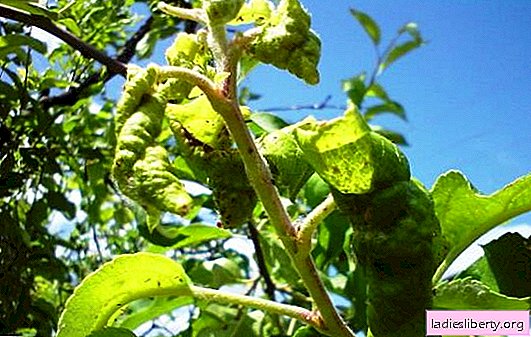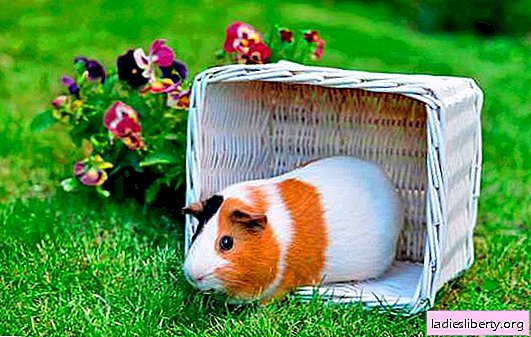
Fruit plants, including pear during flowering and fruiting are exposed to various kinds of diseases and pests.
One of the most insidious and dangerous pests is rightfully considered to be an aphid - a translucent and therefore almost invisible insect on the leaves, whose body length rarely exceeds five millimeters.
It is about this insect, the signs of its appearance in the garden and the methods of struggle for preserving the coming harvest and the healthy state of the pear tree.

About aphids on a pear - what a beast
Aphids as a species are common in Russia, southern Europe, the Caucasus and Central Asia. Outwardly, it is a barely distinguishable and sedentary insect, which, in addition to a green hue, has a gray color, pink and even black. The body length of aphids barely exceeds five millimeters. This pear pest does not attack plants alone, but in colonies numbering up to several hundred individuals.
Aphid colonies on pear grow at a tremendous speed. In one summer alone, up to six generations are born, while females lay up to several dozen eggs. After two to three weeks, the larvae hatching from these eggs are ready to lay their eggs themselves. Thus, the process is repeated up to six times during the summer, after which a generation of winged insects appears, which fly to other plants to establish their own colonies.
Aphids love the juicy parts of the pear very much: it spreads on the inflorescences, young shoots and the shadow side of the leaves, inside unblown buds and literally sucks vital juices from the affected tree.
Aphids on a pear. Photo of the effects of the pest

Signs of Pear Aphid Damage
Many gardeners are faced with the aphid problem, with an enviable constancy of agricultural lands affecting insatiable colonies. It is difficult to get rid of aphids, therefore, knowledge of the first signs of its appearance on a pear tree is difficult to underestimate.
What applies to the signs of the appearance of this pest in the garden? Let's try to figure it out.
1. With the naked eye, visible aphid colonies on a pear. First of all, pests inhabit the shady sides of young leaves, where it is easy to notice them, you just have to turn the leaf plate over,
2. deformed tops of plants. Aphid colonies suck life juices from young leaves of a pear, flowers and ovaries, after which the latter are strongly bent and are a clear sign of the disease,
3. black plaque that struck shoots and leaves. As a result of vital activity, aphids excrete excrement, which includes sugar. A sooty fungus settles on this sweet pad, which, as it spreads, stains the shoots and leaves yellow, giving them the appearance of burnt,
4. unhealthy appearance. This feature is especially noticeable on young plants - they look oppressed, lose their former elasticity and eventually fall off.
Prevention of the appearance of aphids on a tree
To prevent the appearance of aphids on pear and other fruit trees, plants are planted in open places devoid of shade. Also, the technique and planting scheme are respected, so there will be no excessive thickening of plants and the appearance of a shadow with it, which so attracts pests.
Together with the measures taken, a systematic fight is carried out with ants that can spread aphids to your site.
The regime of fertilizing and watering plants is respected. Often, crops that have overeated fertilizers begin to form new leaf plates and shoots at an accelerated pace. This is not bad, only these neoplasms are too soft and vulnerable, which will be appreciated by the aphids, which can easily bite through this cover.
Do not neglect the procedures for weeding and ridding the site of fallen leaves and other unnecessary plant debris. On overgrown weeds and unnecessary parts of garden crops, the aphid feels just as well and actively reproduces. Therefore, you should visit your garden as often as possible, do the cleaning and carefully monitor the appearance of pests. At the first sign of aphids, appropriate measures must be taken immediately.
Pear Pest Management Methods
There are three main methods for fighting pear aphids, which include:
1. mechanical impact - the collection of affected parts of the plant and the destruction together with the insects settled on them,
2. use of chemicals - the use of special chemicals is supposed to rid the garden of pests,
3. folk methods of cure - ways to combat aphids using folk remedies.
Spraying a tree with chemicals as a means of getting rid of pear pests
Chemicals against aphids on pear
Chemicals are used at least three weeks before harvesting and eating it or preparing it for the winter. The chemical method of getting rid of pear pests is very powerful and effective. Insecticides themselves are divided into three types of exposure:
- contact - this type of chemical agent immediately acts on pests, penetrating the body through the outer integument of the body and poisoning it. These substances include Fufanon (another name - Fufan), as well as Fury, Arrivo, Karbasos and some others. There is one nuance in the use of contact preparations: the aphid immediately realizes that it is in danger, and therefore multiplies much faster.
- intestinal insecticides - a similar type of drug enters directly into the intestinal system of aphids, poisoning the insect and immediately leading to death. The most widely used are Confidor and BI-28 Novy. They are best used together with contact insecticides - thus the effectiveness of the procedures for cleaning the site of pear pests will increase several times.
- systemic drugs - the plants themselves are treated with these insecticides, after which the aphid, gnawing poisonous leaves and buds, soon dies. “Aktara” is the most popular among these products - it can be used to process only the lower parts of pear leaves, it works even during rains, but the effect is not as fast as when using other insecticides.
When using chemical means of protection against pear pests, it should be remembered that they act not only on uninvited guests, but also on beneficial insects: ants, ladybugs and other predators who love to feast on aphids will not die.
It is also unacceptable to process the pear during its flowering, because this is fraught with the death of bees. The ideal weather for using insecticides is dry and clear with no signs of wind. It is necessary to process only the lower parts of the leaf plates and change the preparation from time to time, since aphids have the ability to develop immunity against the used insecticides.
We destroy the pest pest with the help of folk remedies
Many gardeners and gardeners prefer the use of folk remedies for pear aphids to chemists - this saves money and minimizes environmental damage. And what kind of person is not pleased to eat completely environmentally friendly fruits from their lands?
The first assistant in saving a pear from aphids is rightfully the use of a solution of vegetable oil and liquid soap. With this tool, the affected areas of the tree are sprayed several times every night until the pests are completely destroyed.
Decoctions prepared on the basis of wood ash or tar soap will also help in the fight against aphids. Similar drugs from wormwood, tobacco dust, yarrow, bitter pepper, dandelion, onions, rhubarb or mustard will have the same devastating effect on intruders.
Aphids cannot tolerate infusions based on hot peppers. This drug is mixed with soapy water and spray the infected areas of the pear until the pear pests disappear completely.
Decoctions of potato leaves, tomato or common nettle are also used. Advice seems inappropriate, as the aphids feed on the juices of these plants. However, if you keep aphids in water for a night or longer and spray the lower parts of the leaves of the affected pear with the resulting drug, the result will surprise you with its speed.
If you observe all of the above conditions for caring for a pear, planting pattern, feeding regimen, as well as quickly respond to the first signs of ill health, a rich harvest will not take long. Rich autumn for you!













